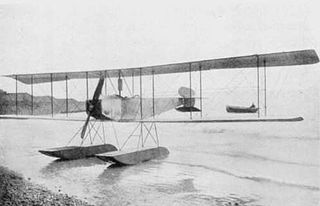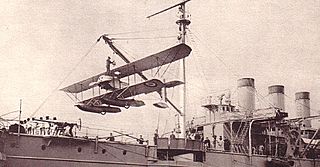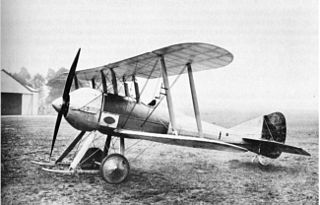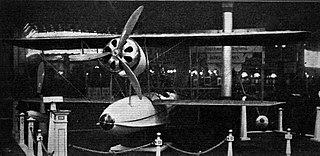Related Research Articles

The Avro 504 was a First World War biplane aircraft made by the Avro aircraft company and under licence by others. Production during the war totalled 8,970 and continued for almost 20 years, making it the most-produced aircraft of any kind that served in any military capacity during the First World War. More than 10,000 were built from 1913 until production ended in 1932.

The Sopwith Tabloid and Sopwith Schneider (floatplane) were British biplanes, originally designed as sports aircraft and later adapted for military use. They were among the first successful types to be built by the Sopwith Aviation Company. The "Tabloid", so named because of its small size, caused a sensation when it made its first public appearance.

The Avro Type D was an aircraft built in 1911 by the pioneer British aircraft designer A.V. Roe. Roe had previously built and flown several aircraft at Brooklands, most being tractor layout triplanes. The Type D was his first biplane.

The Avro Type E, Type 500, and Type 502 made up a family of early British military aircraft, regarded by Alliott Verdon Roe as his firm's first truly successful design. It was a forerunner of the Avro 504, one of the outstanding aircraft of the First World War.

The Avro Type H, Type 501, and Type 503 were a family of early British military seaplanes. They were a development of the Avro 500 design and were originally conceived of as amphibious, the prototype being fitted with a single large main float under the fuselage, and two outrigger floats under the wings.

The Bristol T.B.8, or Bristol-Coanda T.B.8 was an early British biplane built by the Bristol Aeroplane Company and designed by the Romanian Henri Coandă. Fifty four Bristol T.B.8s were built, being mainly used as a trainer. A small number of Bristol T.B.8s were briefly used as bombers at the start of the World War I by the Royal Naval Air Service.

The Bristol Gordon England biplanes were a series of early British military biplane aircraft designed by Eric Gordon England for the Bristol Aeroplane Company that first flew in 1912. Designed for easy ground transport, the aircraft could be quickly disassembled.
The Sopwith Admiralty Type 807 was a 1910s British biplane seaplane designed and built for the Admiralty by the Sopwith Aviation Company.
The Sopwith Two-Seat Scout was a 1910s British biplane Anti-Zeppelin scout biplane designed and built for the Admiralty by the Sopwith Aviation Company. It was nicknamed the Spinning Jenny due to a tendency to enter a spin.
The Avro 539 was a British single-seat racing biplane built by Avro for the 1919 Schneider Trophy.

The Caudron J Marine was an amphibious, two-seat, biplane equipped with floats and wheels, similar to the earlier Caudron J floatplane.
The Lakes Water Bird, sometimes known as the Avro Curtiss-type, is remembered as the first consistently successful British seaplane, developed by the Windermere-based Lakes Flying Company, during 1911.

The Blackburn Type I was a single-engine civil two-seat monoplane built in the United Kingdom in 1913. Three were produced and used for flying demonstrations and training including seaplane pilotage.
The Avro Burga was built by Avro for R.F. Burga to test his unique system of lateral control. It was a single-engined two-seat monoplane, fitted with differentially operated surfaces above and below the central fuselage.

The Royal Aircraft Factory S.E.2 was an early British single-seat scout aircraft. Designed and built at the Royal Aircraft Factory in 1912–13 as the B.S.1, the prototype was rebuilt several times before serving with the Royal Flying Corps over the Western Front in the early months of the First World War.

The Short S.41 was a British single-engined biplane built for the Royal Navy in 1912. Capable of being operated either on wheels or floats, it was successful enough for a further two similar aircraft to be built, with the type remaining in use until the early years of the First World War.

The Dunne D.8 of 1912 was a tailless swept wing biplane, designed by J. W. Dunne to have inherent stability. One example was supplied to RAE Farnborough. License-built Burgess-Dunne models were used by the US Signal Corps and United States Navy and the short-lived Canadian Aviation Corps. It was the latter's first and only warplane.
The London and Provincial Fuselage Biplane was a British single-engined two-seat training aircraft of the First World War. While the aircraft demonstrated excellent manoeuvrability, only a single example was built.

The ASL Viking was a single-engined two seater biplane aircraft designed and built by Horatio Barber's Aeronautical Syndicate Ltd. at Hendon. It was first flown in January 1912.

The Pemberton-Billing P.B.1, sometimes known as the Supermarine, was a 1910s British single-seat flying-boat built by Pemberton-Billing Limited, which later became the Supermarine Aviation Works. Only one P.B.1 was built, and it never flew any distance further than a hop.
References
- ↑ Jackson 1965, pp. 36–7
- Jackson, Aubrey Joseph (1965). Avro Aircraft Since 1908. Putnam. ISBN 978-0-85177-834-1.
- Lewis, P RBritish Aircraft 1809-1914. London, Putnam: 1962